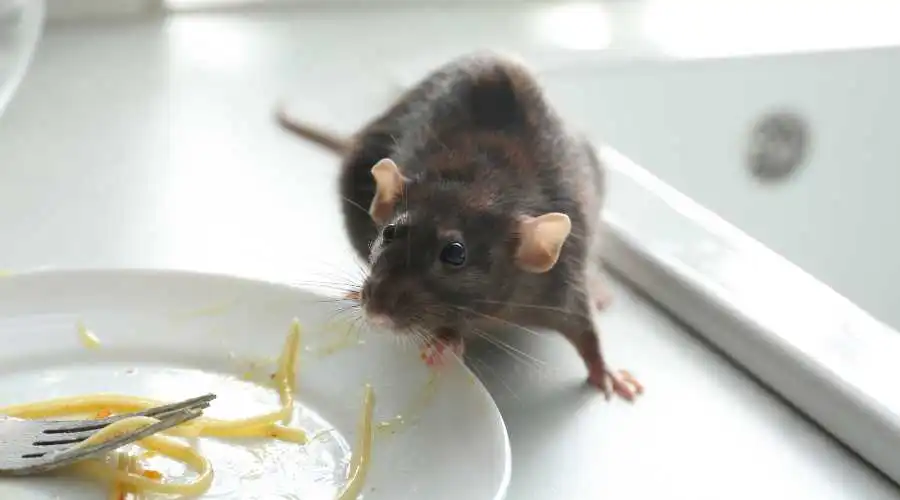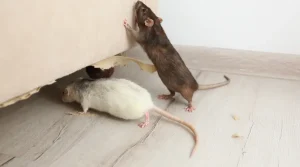How these bugs are even entering my house is a typical query we get from several residents—the solution? In whatever way they can. Bark scorpions, for example, may slip between a gap of 1/8″ or the width of a credit card, which is common among pests in the California region. Roof rats need more room but may still enter via relatively small gaps. The four most typical points of entry for pests into houses in the Valley are listed below.
Common ways pests enter your home:
- Improperly sealed doorways
- Cracks in the foundation
- Foundation utility penetrations
- Roof vents
- People
Common pest entry points
Under doorways
For many pests, this is the most frequent method of entry. Many house front doors do not close securely against the threshold, leaving just enough room for vermin to squeeze through. Due to wear and strain, the garage door may have lost its ability to establish a tight seal against the concrete.
Many pests, including roaches and scorpions, can fit through small crevices. They will use any window of opportunity surrounding your doors to enter your house. For Windows, the same holds. Pests may enter a closed window via holes surrounding the frame, another issue visible in the case of a torn window screen.
These issues may be resolved by installing weatherstripping all the way around the door and ensuring it fits firmly within the frame. The door may also need replacement.
You’ll need to contact a garage door expert to repair the rubberized seal, also known as the “astragal,” if your garage door does not seal with the ground because it is ripped, worn, or otherwise damaged. Any screens with tears or holes should be replaced.
Windows, and look for gaps all around the window.
Inside of foundation cracks
Most pests enter houses via the foundation, where your home and the ground connect. It seems reasonable that bugs would use cracks in the foundation to enter the walls. Spiders, termites, cockroaches, and ants may squeeze through minor fundamental fractures or gaps. Your home’s moisture, food, and warmth will all attract them inside. Once inside, they may destroy your possessions, contaminate your food, and proliferate. The key to preventing these pests from entering your home is prevention. In the following part, we’ll go over the benefits of our home sealing service and our foundation crack sealing method.
Penetrations in foundations
Utilities must flow through the foundation in all dwellings. Insects may still burrow up into your home via any of these openings. Termites are notorious in the Valley for appearing under sinks and behind toilets.
Through roof vents
Roof vents at the roof line are standard in California stucco houses. These vents are vital in your home because they enable moisture and heat to escape the roof by traveling from the vent at the ridge to the vent in the eve or gable. However,
if left unprotected, they may provide an entry point for pests, particularly roof rats, into your property.
This is particularly likely when trees overhang or are near the roof. Rats will climb the trees and then go on a limb to your house. They’ll then enter the attic through an unprotected vent.
So, how precisely do you restrict this access? First and foremost, do not restrict the roof vents in any way. This might result in serious moisture accumulation concerns in your attic and roof. Instead, place a metal mesh or grate-like material over each hole. This permits air to enter and depart while preventing anything as huge as a roof rat from entering. Because your house most likely already has these covers, another crucial responsibility is to ensure that this mesh barrier remains in excellent condition and continues to limit access to each vent.
The homeowner
Okay, there is an aspect of pest defense that our home sealing service only sometimes addresses. However, the homeowner accidentally introduces many pests, most notably bed bugs, roaches, crickets, and rodents, into the house. These hitchhikers might be in the cardboard box holding your online purchase or your luggage from a prior journey. They are there regardless of how they got there. Because the homeowner allowed them in by mistake.
Bugs can be kept at bay in your house. By doing the following:
— To prevent bed bugs from spreading from one area to another, take precautions when traveling; keep your baggage and personal stuff on hard surfaces, for example.
You examine your mattress and couches for bugs before sitting or lying down. Also, as soon as you arrive home, wash and dry your clothes and baggage.
— To avoid attracting other pests, open cardboard items left on the porch outside and carry the contents of those boxes inside separately.
– You could want to open boxes on your porch or garage and move your item inside, leaving the packaging in the container outside.
You may accomplish so with the help of our specialists Prevent pest access.
Thousand Oaks Pest Control offers a way to keep pests from your home: home sealing. This 25-step process starts with examining pest entrance points in your home. Our staff then goes to work sealing or blocking those entrance points. We caulk around air conditioners and electrical boxes, add weatherstripping, screen roof vents, and close windows with caulking.
If your Valley home has been infested, Contact us for a free pest check. If you have pests inquire about our home sealing service.




